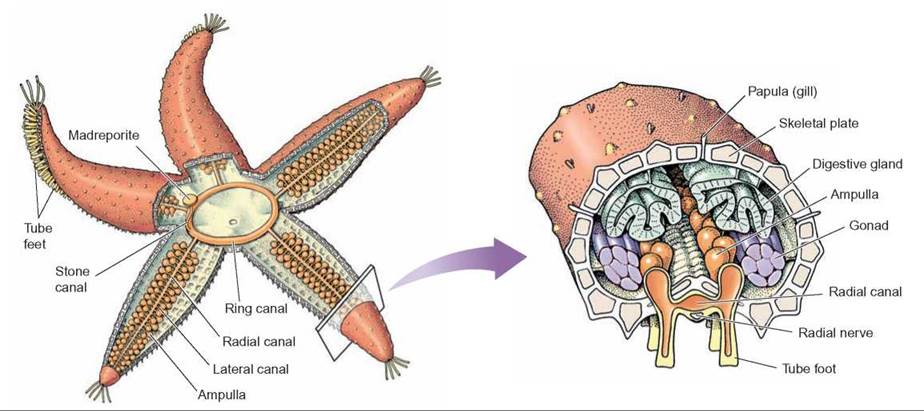CONCEPTS IN BIOLOGY
PART V. THE ORIGIN AND CLASSIFICATION OF LIFE
23. The Animal Kingdom
23.12. Echinodermata
The echinoderms represent a completely different line of evolution from other invertebrates. They are actually more closely related to the vertebrates than to other invertebrates. Echinoderms, along with chordates, have an embryological development, in which the anus is the first opening of the gut to form. Such animals are called deuterostomes. In all other triploblastic organisms, the mouth is the first opening of the gut to form; these are called protostomes. All echinoderms are marine benthic animals and are found in all regions, from the shoreline to the deep portions of the ocean. Echinoderms are the most common type of animal on much of the ocean floor. Most species are free-moving and either are carnivores or feed on detritus.
They are unique among the more advanced invertebrates in that they display radial symmetry. They have a five-part radial symmetry; thus, they have five arms or regions of the body that project from a central axis. However, the larval stage has bilateral symmetry, leading many biologists to believe that the echinoderm ancestors were bilaterally symmetrical.
Another unique characteristic of this group is their water vascular system (figure 23.25). In this system, water is taken in through a structure on the top side of the animal and then moves through a series of canals. The passage of water through this water vascular system is involved in the organism’s locomotion.

FIGURE 23.25. Water Vascular System
Echinoderms move by means of a water vascular system. Water enters the system through an opening, travels to the radial canals, and is forced into the tube feet.
They have a hard, jointed internal skeleton covered by a thin skin. Many of them have spines that are part of the skeleton and project from the animal.
There are five major types of echinoderms: starfish, brittle stars, sea urchins, sea cucumbers, and crinoids (figure 23.26). Starfish, brittle stars, and sea urchins move slowly along the ocean bottom and feed primarily on detritus. Some starfish are carnivores that eat clams. Crinoids are sessile, and many of them are stalked. Because they have five arms that are often feather-like, they are often called sea lilies or feather stars. They are filter feeders. Sea cucumbers are sausage-shaped organisms that lie on the bottom or burrow in the mud. Some are detritus feeders and some are filter feeders.

FIGURE 23.26. Echinoderm Diversity
Echinoderms have a five-part radial symmetry and an internal skeleton. Many of them have spines that protrude from the surface. There are five major types of echinoderms: starfish, brittle stars, sea urchins, sea cucumbers, and crinoids (feather stars).
23.12. CONCEPT REVIEW
29. Describe the general body plan of an echinoderm.
30. What is a water vascular system, and what does it do?